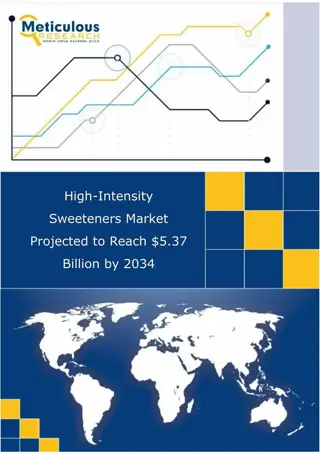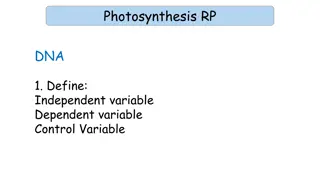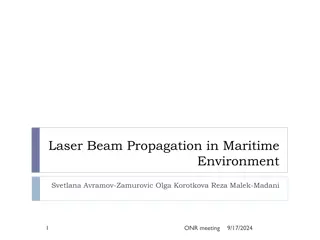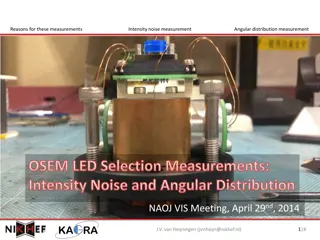Understanding Light Intensity: Measuring Different Light Sources
Explore the concept of light intensity by measuring various light sources and their efficiency. Through practical experiments, understand the relationship between light intensity and the output of different light sources. Theoretical frameworks, practical applications, and key concepts are discussed to enhance learning.
Download Presentation

Please find below an Image/Link to download the presentation.
The content on the website is provided AS IS for your information and personal use only. It may not be sold, licensed, or shared on other websites without obtaining consent from the author. Download presentation by click this link. If you encounter any issues during the download, it is possible that the publisher has removed the file from their server.
E N D
Presentation Transcript
Variation of light intensity Measuring the light intensity of different light sources
Variation of light intensity Measuring the light intensity of different light sources Objective Relate light intensity and light source efficiency to create a hypothesis about the amount of light sent out by different light sources and proceed it to test using the Labdisc light sensor.
Variation of light intensity Measuring the light intensity of different light sources Introduction and theory The aim of the introduction is to focus students on the lesson subject by refreshing acquired knowledge and asking questions which encourage research development. Key concepts from the theoretical framework, applied by the students during the lesson, are taught. Introduction Have you ever experienced a electricity blackout when it is dark outside? Usually people run to find candles and flashlights so they can see something in the pitch- black. Even if we try to light the room by placing several candles around, or use the most powerful flashlight we have, it may still not be enough to brighten the room as well as a light bulb could. How should we place several candles in a room in order to achieve the most light?
Variation of light intensity Measuring the light intensity of different light sources Introduction and theory What do you think the efficiency of a light source depends on? Carry out the experiment activity with your class so that at the end you ll be able to answer the following question: How are the intensity and efficiency of a light source related?
Variation of light intensity Measuring the light intensity of different light sources Introduction and theory Theoretical The luminous flux gives us an idea about the light intensity sent out by light sources in all space dimensions, for example by a light bulb. But when you consider a projector, it is clear that it lights only in one direction - forward. That is why we need to know how the luminous flux is distributed into every space dimension, using the definition of light intensity.
Variation of light intensity Measuring the light intensity of different light sources Introduction and theory Light intensity (I) is defined as the luminous flux that is emitted per unit of solid angle (steradian) into a specific direction . The unit of measure is the lumen per steradian, or candela (cd). The mathematical equation that defines light intensity is: What is this? = light intensity (cd) F = luminous flux (it is measured in lumens, meaning luminous power perceived per unit area) = differential of solid angle (steradians)
Variation of light intensity Measuring the light intensity of different light sources Introduction and theory Now students are encouraged to raise a hypothesis which must be tested with an experiment. If light intensity and light efficiency are related, how would the efficiency vary depending on the light source?
Variation of light intensity Measuring the light intensity of different light sources Activity description Students will measure the light intensity of different light sources using the Labdisc light sensor. Based on the results, the students will proceed to relate each light source to its corresponding light efficiency.
Variation of light intensity Measuring the light intensity of different light sources Resources and materials Labdisc USB connector cable LED flashlight with batteries Candle Fluorescent light bulb Matches Lamp with an 11 watt vial
Variation of light intensity Measuring the light intensity of different light sources Using the Labdisc a. Using the Labdisc To collect measurements with the Labdisc light sensor, the Labdisc must be configured according to the following steps: Turn on the Labdisc by pressing Press , and select SETUP by pressing Now select the option SET SENSORS with Select only the light sensor and then press Once you have done that, you will return to setup, press select SAMPLING RATE with once and Select MANUAL with and then press
Variation of light intensity Measuring the light intensity of different light sources Using the Labdisc Press and select NUMBER OF SAMPLES with Select MANUAL with and then press To return to the measurements press three times. Then press to start measuring. Press the button each time you want to measure. Once you`ve finished measuring stop the Labdisc by pressing (you will see the instruction Press SCROLL key to STOP ) and press
Variation of light intensity Measuring the light intensity of different light sources Experiment The following steps explain how to perform the experiment: Place the four different light sources approximately 30 cm. away, in the following order: Lamp, flashlight, fluorescent bulb and candle. Darken the room covering the windows and turning off any artificial light sources. To collect the data place the sensor approximately 10 cm. away from the light source. Push the button of the Labdisc. Turn the lamp on and observe how the measurements vary on the Labdisc screen.
Variation of light intensity Measuring the light intensity of different light sources Experiment Wait until the intensity value you are measuring stabilizes. Take just one manual sample of the light intensity. Once you are done with the lamp - turn it off without turning off the Labdisc, and then turn on the LED flashlight. Repeat step five and six. Measure the light intensity of the candle and the fluorescent tube as you did with the other light sources. Leave the dark room in order to measure the light intensity in the outdoor sunlight and then the intensity of light when pointing the light sensor directly at the sun. Once you`ve finished measuring turn the Labdisc off.
Variation of light intensity Measuring the light intensity of different light sources Results and analysis The following steps explain how to analyze the experiment results: Connect the Labdisc to the computer using the USB communication cable or via the Bluetooth wireless communication channel. On the upper menu press the button and select Select the last experiment of the list. Observe the graph displayed on the screen. Press the Bar-graph icon and set the display to a Bar Graph display. Press the button and write annotations on the graph specifying your observations according to the moment you registered the data.
Variation of light intensity Measuring the light intensity of different light sources Results and analysis How do the results relate to your initial hypothesis? Explain. How do the data curves vary for each light source? What similarities do the data curves present? Which was the brightest light source? Which was the least bright?
Variation of light intensity Measuring the light intensity of different light sources Results and analysis The graph below should be similar to the one the students came up with.
Variation of light intensity Measuring the light intensity of different light sources Conclusions Following are some questions and answers which should be developed by students in order to elaborate on their conclusions. What was the variation between the different light sources you analyzed? Students should analyze the different values of light intensity, defining which were the highest and lowest and the range of variation between them. How does the amount of light relate to the light intensity? Students should relate more powerful light sources to greater light intensity and less bright light sources, like a candle, to less light intensity.
Variation of light intensity Measuring the light intensity of different light sources Conclusions How do you think the light flux varies in each of the light sources you analyzed? Students should conclude that the more light intensity, the more luminous flux there is. Both parameters depend on the relative distance between the location of the Labdisc light sensor and the light source. According to your experience, which do you think is the most efficient light source from the three artificial sources studied? Students should indicate that the most efficient light source is the LED flashlight, because it uses less energy to function, for this reason it is considered to be energy saving. Students should reach the following conclusions: Different light sources have different light intensities and this relates to their associated functions. However, light intensity cannot be related to the efficiency of the source. The LED flashlight is not the most luminous source, but presents greater energy efficiency than the candle and the lamp. On the other hand, sunlight is the most powerful light source and yet, is the most efficient.
Variation of light intensity Measuring the light intensity of different light sources Activities for further application The aim of this section is for students to extrapolate the acquired knowledge during this class through its application in different contexts and situations. Furthermore, it is intended that students question and present possible explanations to the experimentally observed phenomena. Further questions: How could you increase the light intensity of a candle? Students should explain that they could achieve this by increasing the amount of light the candle produces, in other words, making the flame larger. We can establish the following connection: The larger the candle flame is, the more light intensity it produces, and vice versa (the smaller the candle flame, the less light intensity).
Variation of light intensity Measuring the light intensity of different light sources Activities for further application How are light intensity and electric power related? Students are expected to establish that light sources which emit more light intensity use more energy in the process. On the other hand, we should point out the example of the candle, which uses less energy in the lighting process. In both cases energy is lost through heat. This shows that light efficiency depends on how much energy we use to illuminate, rather than produce heat. How is a natural light source like the sun different from an artificial light source such as a light bulb? Students should quantify that the sun s light intensity is much higher than the intensity of any artificial light source, and that this depends directly on the amount of energy used by the sun to produce this intensity of light.























